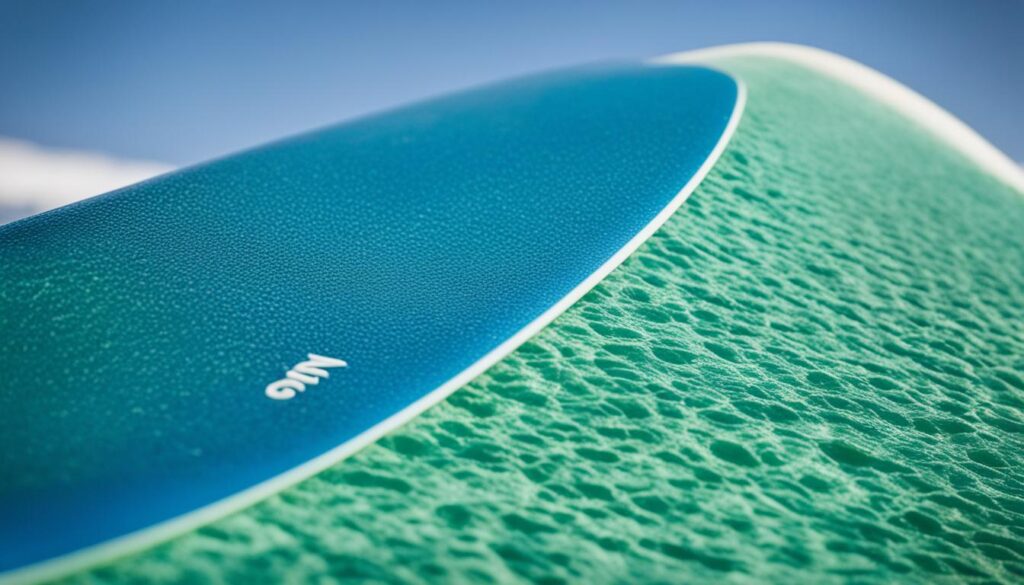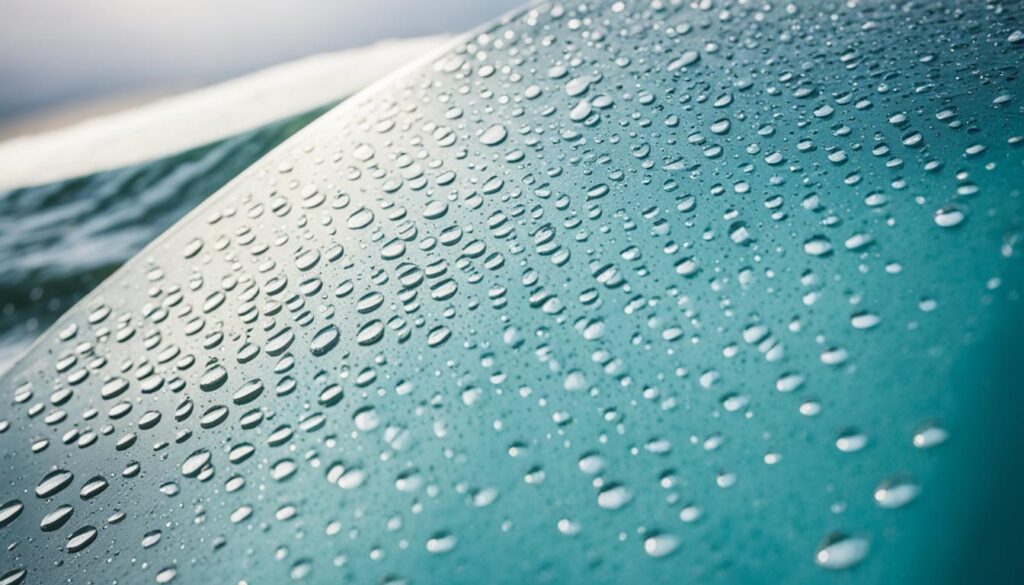When it comes to surfing, the right equipment can make all the difference in your performance. But what about surfboard fins? Are they really universal? Can you use any fin on any surfboard? If you’ve ever pondered these questions or assumed that all surfboard fins are the same, it’s time to take a closer look. In this article, we’ll explore the intricacies of surfboard fin compatibility and uncover the factors that determine whether a fin will work with your surfboard or not.
Surfboard fins are a crucial component of your surfboard setup, influencing your stability, speed, maneuverability, and control on the waves. Understanding the different types of fins and their characteristics is essential to finding the perfect fit for your surfboard and surfing style. So, let’s dive in and unravel the mystery of surfboard fin compatibility!
Key Takeaways:
- Surfboard fins are not universal, and their compatibility depends on factors such as the surfboard’s fin configuration and type of fin box used.
- The various types of surfboard fins include single fins, twin fins, thruster fins (tri-fins), quad fins, and five-fin setups, each offering different performance characteristics.
- Selecting the right surfboard fin size involves considering factors such as the surfer’s weight, surfboard size, desired responsiveness, stability, and maneuverability.
- The characteristics and design of surfboard fins, including dimensions, shape, flex, and cant, significantly impact their performance in the water.
- The type of fin system used on a surfboard, such as Us box, FCS 1, FCS 2, or Futures, determines the compatibility of fins with the surfboard.
Types of Surfboard Fins and Configurations
Surfboard fins are essential components that greatly influence the performance and maneuverability of your surfboard. Understanding the various types and configurations of surfboard fins is crucial when choosing the right ones for your surfing style and the conditions you’ll be facing.
1. Single Fins
The single fin setup is the earliest surfboard fin configuration. It consists of a single fin positioned at the center of the surfboard’s tail. This configuration offers stability and control, making it ideal for longboards and retro-style boards. Single fins are popular among surfers who prioritize smooth, flowing turns and excellent trim stability.
2. Twin Fins
Twin fins feature two fins positioned close to the tail of the surfboard. This configuration offers enhanced maneuverability and speed, making it popular for smaller and softer waves. Twin fins provide a lively and loose feel, allowing surfers to perform quick turns and generate speed more easily. It’s a favored option for surfers looking for a playful and fun surfing experience.
3. Thruster Fins (Tri-fins)
The thruster fin setup consists of three fins: one larger center fin and two smaller side fins. The thruster setup is the most common and widely used fin configuration in modern surfing. It offers a balanced combination of speed, maneuverability, and control. The center fin provides stability and drive, while the side fins assist with maneuverability and responsiveness. Thruster fins excel in a wide range of wave conditions and are suitable for all skill levels.
4. Quad Fins
Quad fins consist of four fins, with two large side fins and two smaller rear fins. The quad setup offers excellent speed and maneuverability, providing the ability to generate more drive and maintain speed through turns. Quad fins excel in smaller waves and offer exceptional hold and control, making them popular among surfers who enjoy fast, down-the-line surfing and skate-inspired maneuvers.
5. Five-Fin Setups
Five-fin setups, also known as “futures,” are highly versatile configurations that allow surfers to adapt to various wave conditions. This setup combines the thruster and quad fin configurations, offering the option to ride with either three fins or four fins. It provides an exceptional balance of speed, control, and maneuverability, making it a preferred choice for surfers who value versatility and want to fine-tune their board’s performance.
Understanding the characteristics of each surfboard fin configuration is crucial for optimizing your surfing experience. Whether you’re seeking stability, speed, maneuverability, or control, choosing the right surfboard fin configuration can greatly enhance your performance in the water.
| Fin Configuration | Performance Characteristics |
|---|---|
| Single Fin | Stability, Control, Smooth Turns |
| Twin Fins | Maneuverability, Speed, Playfulness |
| Thruster Fins | Balance, Speed, Control, Versatility |
| Quad Fins | Speed, Maneuverability, Hold |
| Five-Fin Setups | Adaptability, Versatility, Speed |
Surfboard Fin Size and Selection
When it comes to surfboard fins, size matters. The right fin size can greatly impact your surfing performance and overall experience in the water. Several factors play a role in determining the ideal fin size, such as your weight, the size of your surfboard, and your personal preferences.
So, how do you select the right fin size for your surfboard? Consider the following:
Desired Level of Responsiveness, Stability, and Maneuverability
Different fin sizes offer varying degrees of responsiveness, stability, and maneuverability. A larger fin provides more stability and control, making it ideal for beginners or surfers who prefer a more stable ride. On the other hand, a smaller fin offers greater maneuverability and responsiveness, suiting surfers who enjoy sharp turns and quick redirection on the wave.
Type of Waves and Wave Conditions
The type of waves you’ll be surfing also affects the ideal fin size. Smaller fins are suitable for smaller, slower waves, as they allow for faster maneuvering. Conversely, larger fins are better suited for bigger, faster waves, as they provide greater stability and control.
Surfboard Design
Consider the specific design of your surfboard when selecting the fin size. Some surfboards are designed to be ridden with larger fins, while others are better suited for smaller fins. Consult the manufacturer’s recommendations or seek advice from knowledgeable surfboard experts to ensure the optimal compatibility between your surfboard design and fin size.
Once you’ve determined the right fin size, proper installation and adjustment are crucial to optimize their performance. A well-installed fin ensures stability, reduces drag, and enhances maneuverability. It is recommended to follow the surfboard fin installation instructions provided by the fin manufacturer or consult a professional for assistance. After installation, fine-tune the fin position and angle to adjust its performance based on your individual preferences.
Remember, finding the perfect fin size is a process of trial and error. Experiment with different sizes and observe how they affect your surfing performance. Don’t be afraid to seek advice from experienced surfers or experts in surfboard fin selection. By understanding your unique needs and considering the factors mentioned above, you’ll be well on your way to finding the ideal fin size for your surfboard.
Surfboard Fin Characteristics and Design
When it comes to surfboard fins, the characteristics and design play a crucial role in determining the performance of your board. Understanding these key features will help you choose the right fins for your desired surfing style and conditions.
Fin Dimensions and Shape
The dimensions and shape of a surfboard fin are important factors to consider. Dimensions such as rake (or sweep), splay, depth, and base length all contribute to the overall performance of the fin. The rake determines the angle at which the fin sweeps back, affecting stability and maneuverability. A larger rake provides better hold and control in powerful waves. Splay refers to the angle between the front and back edges of the fin, influencing how the board releases water during turns. Depth and base length impact the fin’s stability and speed, with longer and deeper fins providing more control and drive.
Surfboard Fin Foil
The foil shape of a surfboard fin refers to the cross-sectional curve from the leading edge to the trailing edge. The foil can be symmetrical, flat on one side and curved on the other, or asymmetric, with a deeper curve on one side. The foil shape affects the flow of water over the fin, influencing speed, lift, and maneuverability. A symmetric foil provides balanced performance, while an asymmetric foil generates more lift on one side, enhancing turning ability.
Fin Flex
The flex or stiffness of a fin can greatly impact its performance. A stiffer fin offers more stability and control, providing better hold and responsiveness in powerful waves. On the other hand, a more flexible fin allows for quicker turns and maneuvers, ideal for smaller or less powerful waves. Finding the right balance of flex is crucial for optimizing the performance of your surfboard.
Fin Cant
The cant of a surfboard fin refers to the angle of tilt in relation to the bottom of the surfboard. A fin with cant influences the board’s maneuverability and responsiveness. A more upright fin provides stability and control, suitable for larger, more powerful waves. In contrast, a fin with a greater cant angle allows for quicker turns and responsiveness, making it ideal for smaller, more playful waves.
By understanding the characteristics and design of surfboard fins, you can make informed decisions when selecting the right fins for your surfboard. Each element contributes to the overall performance and feel of your board, so take the time to experiment and find the perfect combination for your surfing style.

Choosing the Right Fin System
When it comes to surfboard fin compatibility, the type of fin system used on your board is crucial. Different surfboard fin systems have their own advantages and limitations in terms of fin compatibility. Some of the most common fin systems include the Us box, FCS 1, FCS 2, and Futures. Each system offers unique benefits and options for surfers.
The Us box is a versatile and widely used fin system that allows for a wide range of fin options. It provides excellent fin box compatibility, making it easier to find and install compatible fins. Whether you prefer single fins, twins, thrusters, quads, or five-fin setups, the Us box can accommodate your preferred fin configuration. This system offers surfers the flexibility to experiment with different fin setups and customize their performance according to their surfing style and wave conditions.
On the other hand, the FCS 1, FCS 2, and Futures fin systems have their own unique features and benefits. These systems offer quick and convenient fin installation and removal, allowing surfers to easily swap between different fin setups on the same board. However, it’s important to note that these systems may have more specific fin box compatibility requirements. Some fin models may only be compatible with certain fin systems, so it’s essential to ensure that your surfboard has a compatible fin box for the type of fins you want to use.
When choosing the right fin system, consider your desired fin configurations, the level of convenience you need for fin changes, and the availability of compatible fins in the market. Consulting with surfboard experts or experienced surfers can provide valuable insights and recommendations based on your specific needs and preferences.
Key Points:
- Surfboard fin systems play a significant role in fin compatibility.
- Common fin systems include the Us box, FCS 1, FCS 2, and Futures.
- The Us box is a versatile and widely used fin system.
- FCS 1, FCS 2, and Futures fin systems offer convenience in fin installation and removal.
- Ensure your surfboard has a compatible fin box for the type of fins you want to use.
- Consider your desired fin configurations and the availability of compatible fins in the market.
- Consult with surfboard experts or experienced surfers for recommendations.
Finding the Best Surfboard Fins for You
When it comes to choosing the best surfboard fins for you, it’s essential to consider your surfer needs, the process of choosing surfboard fins, and their fin compatibility with your board. Your personal preferences, surfing style, and the specific conditions you’ll be surfing in are key factors to consider in making this decision.
If you are a beginner, you might want to start with a more stable fin configuration that offers control and maneuverability. As you gain experience and confidence, you may prefer fins that provide more speed and responsiveness. It’s all about finding the perfect balance to enhance your surfing experience.
Consulting with surfboard experts is a great idea, as they can offer valuable advice on the right fins for you. Trying out different fin configurations will allow you to determine what works best for your style and the waves you’re riding. Remember, not all surfboard fins are universal, so it’s crucial to choose the right ones for your specific needs and equipment.

